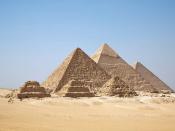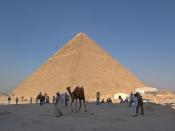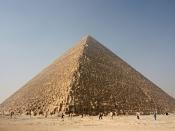One of the seven wonders of the ancient world, the Great Pyramid at Giza stands out of the desert as a man-made mountain, an amalgamated symbol of ancient Egyptian culture, religion, and art. However, though it is the best known pyramid, Khufu's Great Pyramid is but the epitome of constructional magnificence, one monument in a progressive line of increasingly impressive burial chambers. Khufu's pyramid's aesthetic beauty, its geometrical shape, its complex system of internal features, and the precision of its construction beckon us to search for a design scheme. At 145.75 meters (original construction) high, a near perfect square at the base, with sides of 755 feet that differed from each other by less than 8 inches, and faces that sloped upward at an angle of 51 degrees to reach an apex nearly 500 feet above the desert floor
While numerous equally unique theories exist, all exist for one sole purpose: to offer an explanation of just how this great pyramid was constructed, and by whom.
Eriech Van Daniken coaxes us to believe that extra-terrestrials being(s) were the instructional instrument in the construction of the Great Pyramid of Khufu. Margaret Sear and Clifford Wilson would have one believe that the Egyptians cut their own blocks from rock quarries conveniently situated along the Nile, which they then transported across, hauled to the building location, and then dragged them into place with the aid of thousands of workers with unparallel precision. Joseph Davidovits offers the most logical, convincing, and plausible explanation of the construction of the Great Pyramid. He explains that the blocks of the Great Pyramid were actually composed of synthetic stone and were cast directly on the construction scene, eliminating the near impossible task of transporting such blocks (estimated at weighing 2.5 tons each) from the quarries to the site...



Pyramid Construction
You have written a good report but you should include a bibliography at the end of your essay. Also, because of the importance of the title, you should change "Contruction" to "Construction" although I typically don't comment on spelling errors.
11 out of 11 people found this comment useful.